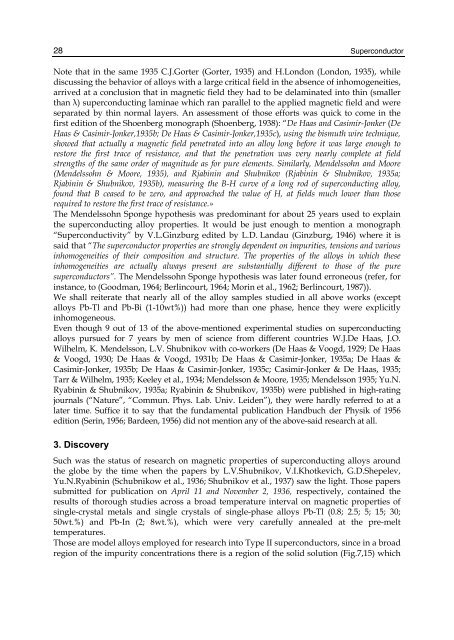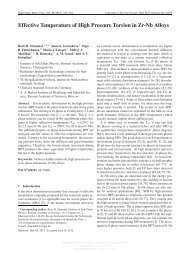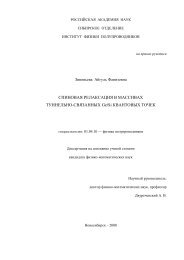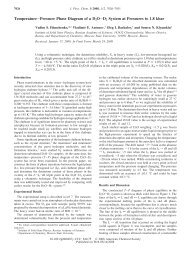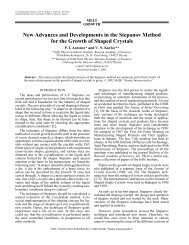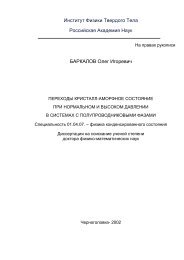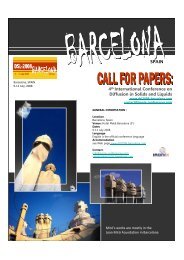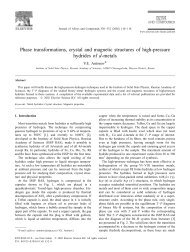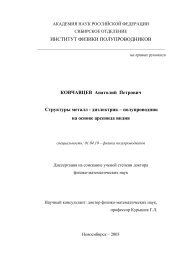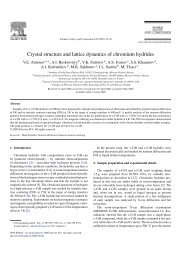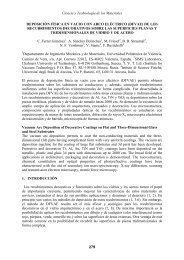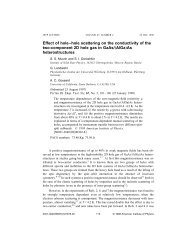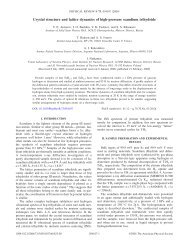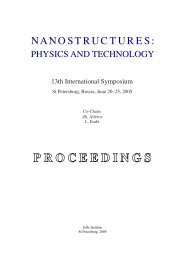Superconductor
Superconductor
Superconductor
Create successful ePaper yourself
Turn your PDF publications into a flip-book with our unique Google optimized e-Paper software.
28<br />
<strong>Superconductor</strong><br />
Note that in the same 1935 C.J.Gorter (Gorter, 1935) and H.London (London, 1935), while<br />
discussing the behavior of alloys with a large critical field in the absence of inhomogeneities,<br />
arrived at a conclusion that in magnetic field they had to be delaminated into thin (smaller<br />
than λ) superconducting laminae which ran parallel to the applied magnetic field and were<br />
separated by thin normal layers. An assessment of those efforts was quick to come in the<br />
first edition of the Shoenberg monograph (Shoenberg, 1938): “De Haas and Casimir-Jonker (De<br />
Haas & Casimir-Jonker,1935b; De Haas & Casimir-Jonker,1935c), using the bismuth wire technique,<br />
showed that actually a magnetic field penetrated into an alloy long before it was large enough to<br />
restore the first trace of resistance, and that the penetration was very nearly complete at field<br />
strengths of the same order of magnitude as for pure elements. Similarly, Mendelssohn and Moore<br />
(Mendelssohn & Moore, 1935), and Rjabinin and Shubnikov (Rjabinin & Shubnikov, 1935a;<br />
Rjabinin & Shubnikov, 1935b), measuring the B-H curve of a long rod of superconducting alloy,<br />
found that B ceased to be zero, and approached the value of H, at fields much lower than those<br />
required to restore the first trace of resistance.»<br />
The Mendelssohn Sponge hypothesis was predominant for about 25 years used to explain<br />
the superconducting alloy properties. It would be just enough to mention a monograph<br />
“Superconductivity” by V.L.Ginzburg edited by L.D. Landau (Ginzburg, 1946) where it is<br />
said that “The superconductor properties are strongly dependent on impurities, tensions and various<br />
inhomogeneities of their composition and structure. The properties of the alloys in which these<br />
inhomogeneities are actually always present are substantially different to those of the pure<br />
superconductors”. The Mendelssohn Sponge hypothesis was later found erroneous (refer, for<br />
instance, to (Goodman, 1964; Berlincourt, 1964; Morin et al., 1962; Berlincourt, 1987)).<br />
We shall reiterate that nearly all of the alloy samples studied in all above works (except<br />
alloys Pb-Tl and Pb-Bi (1-10wt%)) had more than one phase, hence they were explicitly<br />
inhomogeneous.<br />
Even though 9 out of 13 of the above-mentioned experimental studies on superconducting<br />
alloys pursued for 7 years by men of science from different countries W.J.De Haas, J.O.<br />
Wilhelm, K. Mendelsson, L.V. Shubnikov with co-workers (De Haas & Voogd, 1929; De Haas<br />
& Voogd, 1930; De Haas & Voogd, 1931b; De Haas & Casimir-Jonker, 1935a; De Haas &<br />
Casimir-Jonker, 1935b; De Haas & Casimir-Jonker, 1935c; Casimir-Jonker & De Haas, 1935;<br />
Tarr & Wilhelm, 1935; Keeley et al., 1934; Mendelsson & Moore, 1935; Mendelsson 1935; Yu.N.<br />
Ryabinin & Shubnikov, 1935a; Ryabinin & Shubnikov, 1935b) were published in high-rating<br />
journals (“Nature”, “Commun. Phys. Lab. Univ. Leiden”), they were hardly referred to at a<br />
later time. Suffice it to say that the fundamental publication Handbuch der Physik of 1956<br />
edition (Serin, 1956; Bardeen, 1956) did not mention any of the above-said research at all.<br />
3. Discovery<br />
Such was the status of research on magnetic properties of superconducting alloys around<br />
the globe by the time when the papers by L.V.Shubnikov, V.I.Khotkevich, G.D.Shepelev,<br />
Yu.N.Ryabinin (Schubnikow et al., 1936; Shubnikov et al., 1937) saw the light. Those papers<br />
submitted for publication on April 11 and November 2, 1936, respectively, contained the<br />
results of thorough studies across a broad temperature interval on magnetic properties of<br />
single-crystal metals and single crystals of single-phase alloys Pb-Tl (0.8; 2.5; 5; 15; 30;<br />
50wt.%) and Pb-In (2; 8wt.%), which were very carefully annealed at the pre-melt<br />
temperatures.<br />
Those are model alloys employed for research into Type II superconductors, since in a broad<br />
region of the impurity concentrations there is a region of the solid solution (Fig.7,15) which


